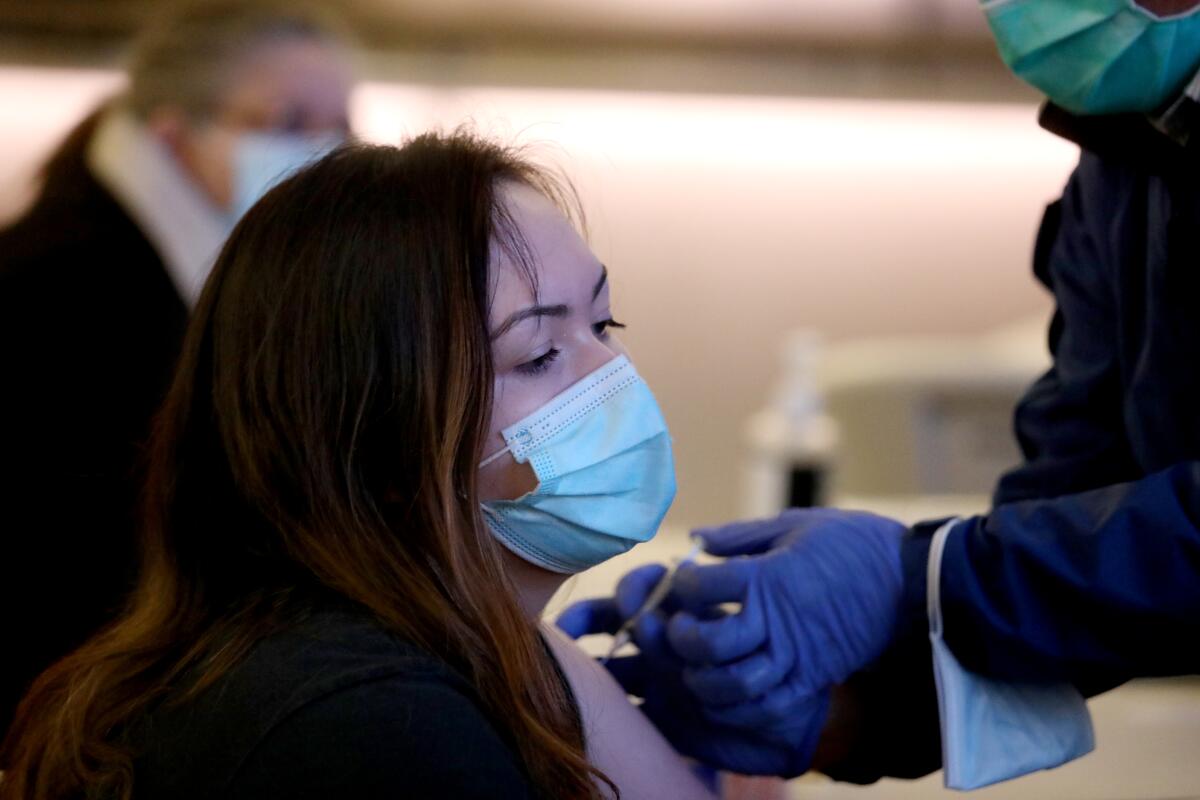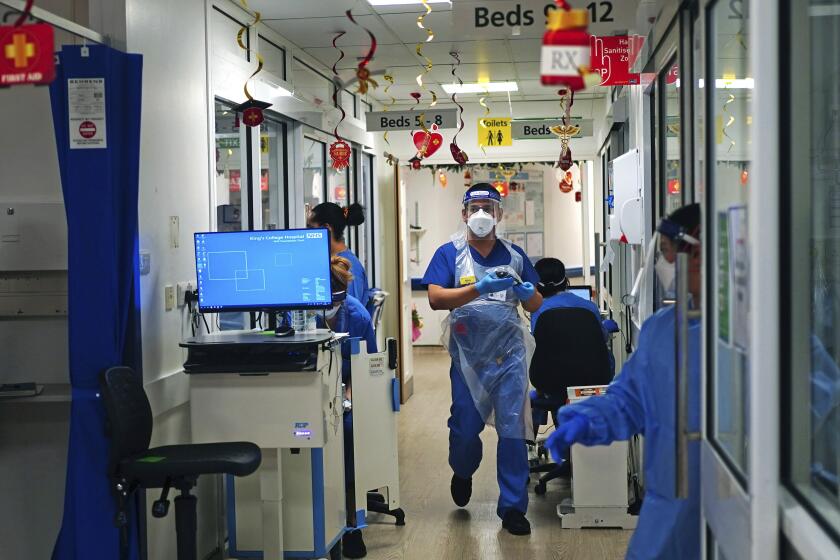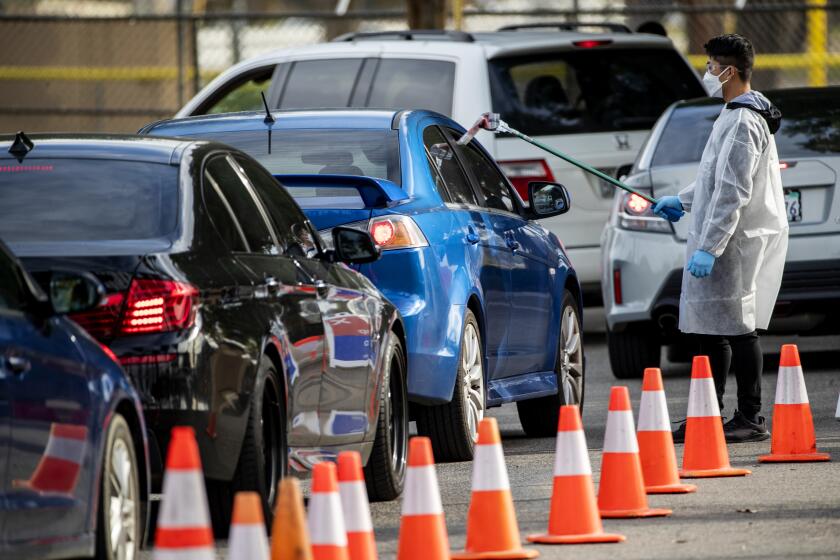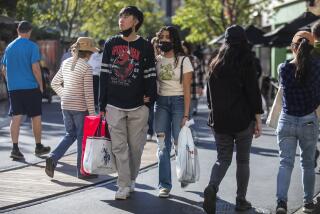Omicron sweeping through California with staggering speed, raising alarms

- Share via
SAN FRANCISCO — California’s winter COVID-19 surge intensified Wednesday, with new coronavirus cases spiking dramatically along with confirmed cases of the Omicron strain, which officials expect will become dominant within weeks in some parts of the state and bring new challenges to the healthcare system.
Because Omicron is so easily transmissible, it is spreading with unprecedented speed. But there are some hints of optimism among early data from England, Scotland, Denmark and South Africa, which suggested that an Omicron infection resulted in a 40% to 70% reduced need for hospitalization compared with the Delta variant. There’s also no evidence that people who are vaccinated and have received a booster shot are getting severely ill with Omicron, unless they have a significantly weakened immune system.
That raises the possibility that this winter in the U.S. won’t be as deadly as last year’s devastating surge. Still, the U.S. has other challenges, with a lower rate of vaccination than Britain or Denmark. But while hospitals in Denmark and South Africa are not being overwhelmed, the healthcare system “is having a tough time in England — because they were already working so hard with Delta, kind of like parts of our country,” said Dr. Eric Topol, director of the Scripps Research Translational Institute in La Jolla.
The biggest worry is that Omicron could spread so fast that some hospitals could still be overwhelmed. The ultra-contagious nature of Omicron means that an extraordinarily high number of people could get infected simultaneously. Even if a lower percentage of them need hospital care, if there are so many more people who are suddenly infected, that could result in strained hospital systems and, in some areas, overwhelm them, especially in areas with low vaccination rates.
The hope is that California, which still has one of the lowest coronavirus case rates in the nation, will be better equipped to handle an Omicron surge than other states that were still reeling from the Delta surge when Omicron started spreading.
“We’re starting off with a much better baseline. There are places like Wisconsin and the Northeast that are really in tough shape with hospitalizations — even before Omicron,” Topol said. “The hope is we will not incur major resource overrunning and staff overrunning in our hospitals throughout the state. But that’s still an unknown right now.”
Here’s what scientists are watching for as they gauge what Omicron has in store for us this winter.
Omicron is expected to move through the population rapidly, at a rate some experts have described as unprecedented on a global scale. “The timeline for Omicron spread is days, not weeks, as it was for Delta,” said San Francisco Health Director Dr. Grant Colfax. Still, he said, “it’s not a time to panic, but a time to be vigilant.”
A highly influential COVID-19 forecast is projecting that the Omicron surge may result in as many as 400,000 new coronavirus cases a day across the nation — significantly higher than last winter’s record of 250,000 cases a day.
The University of Washington’s Institute for Health Metrics and Evaluation projects the Omicron surge will continue rising swiftly through December and into January, potentially peaking later next month or in early February. Despite the increase in cases, predictions indicate there will be fewer daily deaths than during last winter’s devastating peak.
The U.S. is reporting an average of more than 161,000 new coronavirus cases a day, approaching the peak of the summer Delta wave, which reached 164,000 new daily cases.
The number of COVID-19 hospitalizations during this winter’s peak could be slightly higher than last year, the forecast says.
The institute also predicts that single-day COVID-19 deaths could climb as high as 2,000 nationally by early February, about the same number reported during the Delta surge but fewer than the nearly 3,500 daily deaths during last winter’s peak.
The forecast for California projects as many as 150 COVID-19 deaths a day by the end of February, a rate similar to the peak of the summer Delta wave. Still, that is far fewer than last winter’s surge, when California was tallying 550 deaths a day.
Increased mask use could result in substantially fewer coronavirus cases, COVID-19 hospitalizations and deaths, the forecast says.
Early research points to mutations in the spike protein. But much remains unknown or unconfirmed.
In the coming days, COVID-19 hospitalizations will be a more relevant way to determine actions that local authorities may need to take, said Ali Mokdad, a professor of health metrics sciences at the Institute for Health Metrics and Evaluation. That’s because, while Omicron is rapidly spreading, there also will be a relatively high percentage of people infected with the variant who will remain asymptomatic, and a lower percentage of newly infected people who will require hospitalization.
In California, a hopeful scenario would be if Omicron’s disease severity is half of Delta’s and the state can double its booster uptake, raise its vaccination rate to 80% and lower the number of residents’ close contacts for the next month. That would result in a statewide winter peak of 10,000 COVID-19 patients by late January — about half last winter’s surge and 20% worse than the summer Delta wave.
“Although 10,000 hospitalizations ... across the state are far more than we ever want to see, it is more manageable than the alternatives,” said L.A. County Public Health Director Barbara Ferrer. “Realistically, to avoid the worst of the scenarios, we need to work right now to increase vaccinations and booster uptake.”
As of Tuesday, California had 3,589 people with COVID-19 in its hospitals.
Experts say vaccination rates could prove key on what kind of damage Omicron does to some communities. In Los Angeles County, 66% of residents of all ages are fully vaccinated, according to county data. In San Francisco, that number is 80%. The percentages are much lower in the Inland Empire and sections of the Central Valley and rural Northern California.
High rates of vaccination and booster shots are among the reasons why San Francisco health officials seem optimistic that a winter COVID-19 hospitalization surge can be weathered.
Officials say there are still no plans for lockdowns or business closures, suggesting that frequent testing, vaccinations and booster shots make stay-at-home orders an outdated strategy.
Cities are taking other preemptive approaches, such as Oakland’s move this week to join Los Angeles, San Francisco, West Hollywood and Berkeley in requiring proof of vaccination to patronize indoor restaurants and gyms. San Jose’s mayor wants to require all city employees to receive booster shots as a condition of employment and anyone who enters city-owned facilities to do the same.
A highly influential COVID-19 forecast is projecting the Omicron surge may result in as many as 400,000 new coronavirus cases a day across the nation.
Seven UC campuses have delayed in-person return to campus, and all UC and Cal State campuses will require boosters for eligible students. Gov. Gavin Newsom has required boosters for healthcare workers in hopes of protecting the medical community as hospitals fill.
Omicron now constitutes 73% of the nation’s coronavirus cases, up from 13% the week before.
By Wednesday, there had been 191 confirmed cases associated with the Omicron variant reported to the state.
“Within the next two weeks, it’s almost all going to be Omicron,” Ferrer said.
“You should assume it’s Omicron,” Ferrer said the county now tells newly infected residents, “and ... that you’re really isolating because you’re highly infectious.”
The winter combination of Delta and Omicron is raising red flags in L.A. and beyond. Los Angeles County is experiencing a “staggeringly fast rise” in newly confirmed coronavirus cases, with more than 6,500 additional infections reported Wednesday alone, Ferrer said.
The latest daily caseload, 6,509, is more than double the total reported Tuesday. It’s unvaccinated residents who remain particularly exposed to the worst effects of COVID-19. From Dec. 5 to 11, unvaccinated Angelenos were five times likelier to get infected, 21 times more likely to require hospitalization and 18 times likelier to die.
“The reality is that the vast majority of folks testing positive today are infected with Omicron, a more easily transmitted strain of the virus,” Ferrer said. “If our case numbers continue to increase at a rapid pace over this week and next, we could be looking at case numbers we’ve never seen before.”
Times staff writers Colleen Shalby, Hayley Smith and Howard Blume contributed to this report.
More to Read
Sign up for Essential California
The most important California stories and recommendations in your inbox every morning.
You may occasionally receive promotional content from the Los Angeles Times.














